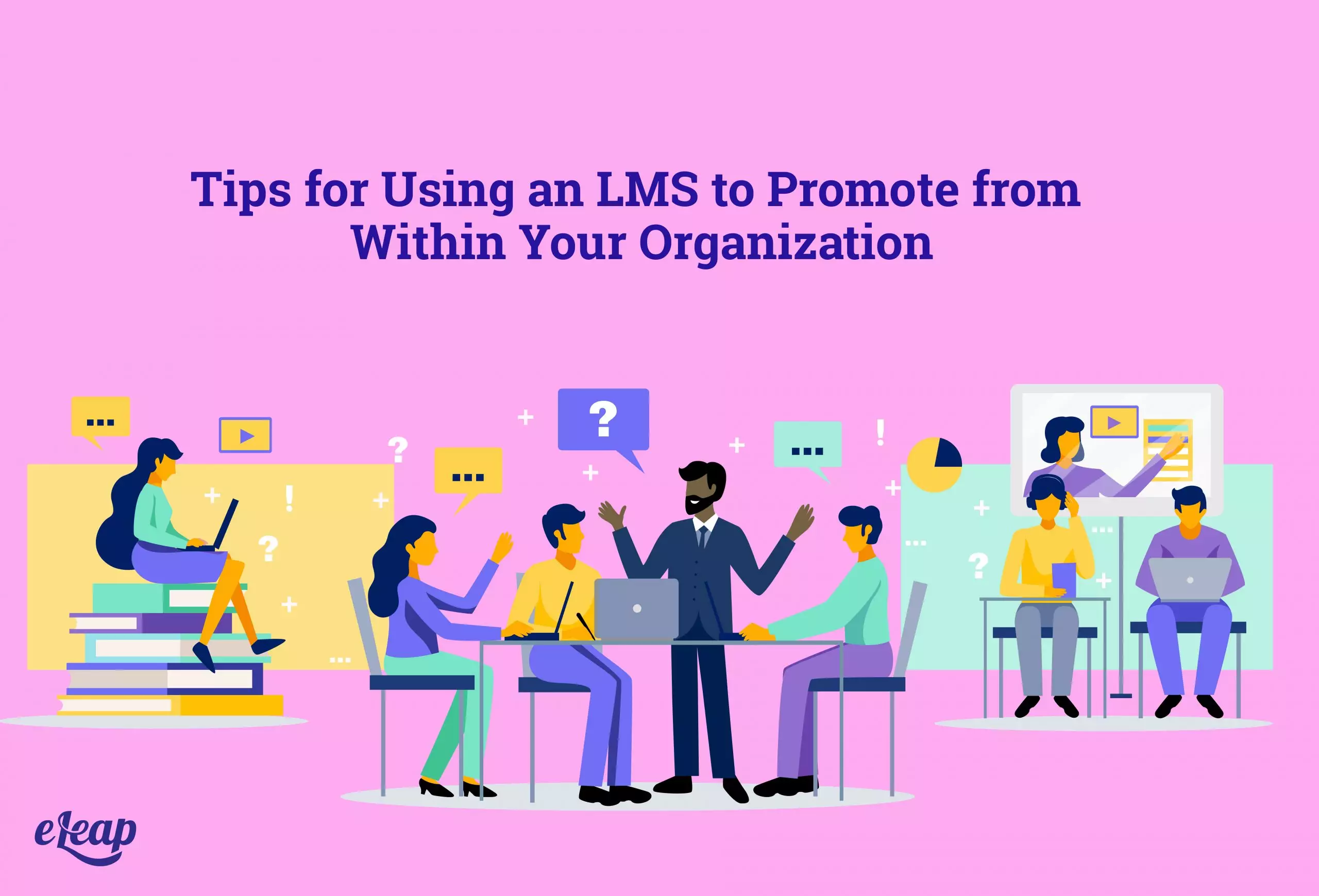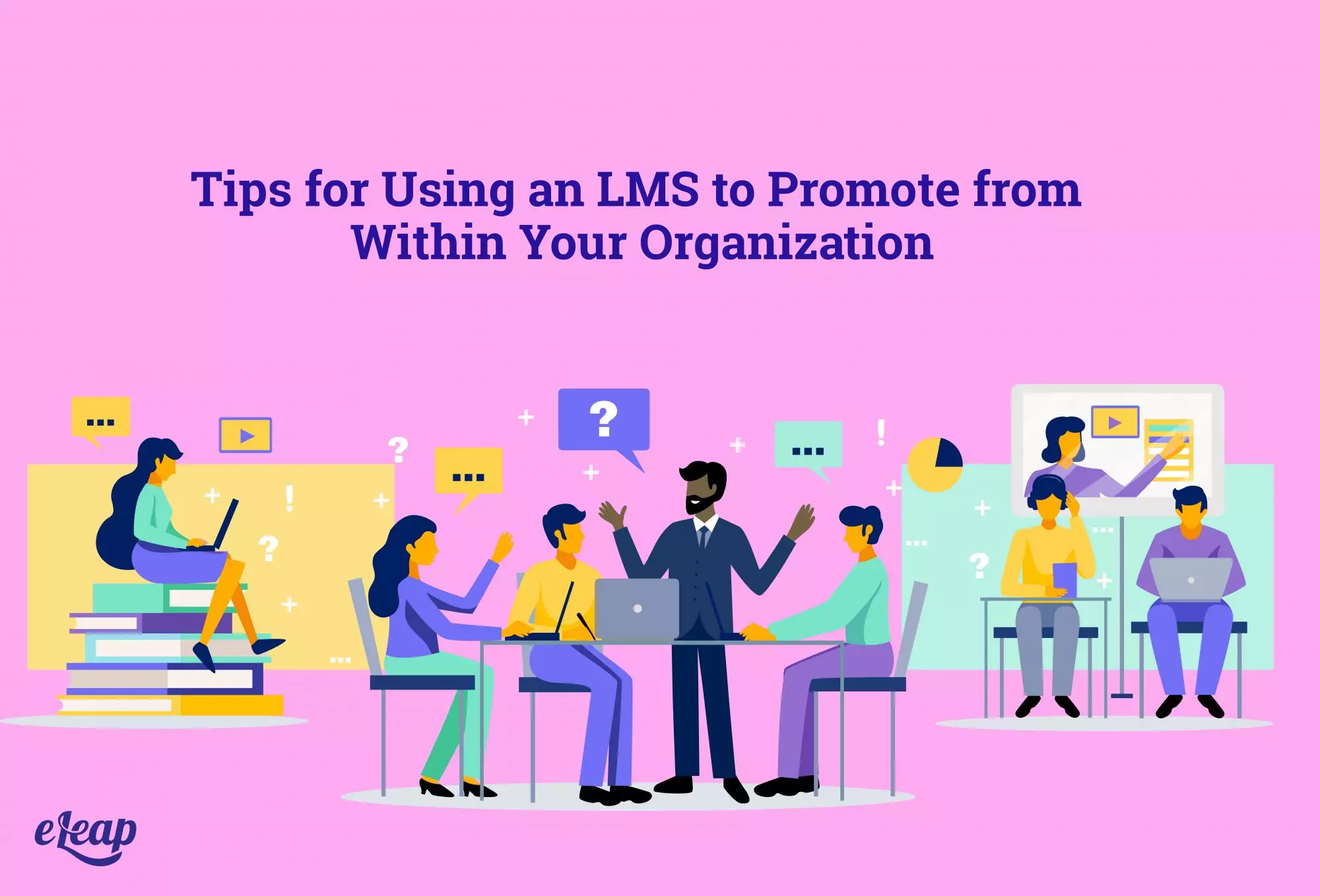Tips for Using an LMS to Promote from Within Your Organization

Your organization is only as strong as the team that powers it. Increasingly, employers realize that team members are not cogs in a wheel that can be easily replaced. In truth, recruiting, onboarding, and training is time-consuming and costly, and a high churn rate can dramatically affect company stability and progress toward mission-critical goals. Using an LMS to help develop strong teams makes your organization stand out.
Attracting, training, and retaining top talent is vital, but can be enormously challenging. A learning management system can help and even make it simpler to promote employees from within, increasing retention and loyalty. In this post, we’ll explore some of the most important tips for using an LMS to promote from within, thereby strengthening your organization.

1. Centralize Knowledge
The first tip is more to do with the LMS itself than with how you use it. If you’re using a fragmented system, stop now. A single, unified LMS centralizes knowledge, reduces confusion among employees about where to go to access those systems, and more. It streamlines training and removes hurdles that might prevent employees from learning and growing. Click here to see how eLeaP helps you centralize and decentralize knowledge.
2. Make Your LMS Part of the Onboarding Process
Your learning management system can provide a wide range of benefits, but only if you put it to use. It should be part and parcel of all processes within your business, including onboarding. Promoting from within begins by identifying talents, aptitudes, skill gaps, and problem areas, and then addressing those to help the employee become well-rounded. Your LMS can also improve the onboarding experience, which makes employees more likely to remain with you for the long term.
3. Create Training Paths that Equate to Career Paths
Really want to make your business stand out and retain top talent? You need to prioritize their career development, then. Your learning management system can be the key to that. Create training paths that equate to career paths. Identify topic areas where course content needs to be created and then map those areas to career progression – create stepping stones that will guide your employees from their current position to the next and then the next. If you want them to remain with you and you want to promote from within, you must help your employees move forward along that path.
4. Create Career Coaching Content
Some companies choose to hire internal career coaches. That’s costly but effective. You can achieve the same thing by creating course content for your LMS that does the same job as a career coach.
Plus, you’ll find that this is a cost-effective approach. Rather than having to pay for a coach time after time, you can create content once and then use it repeatedly. The same career coaching-focused content can give you years of ROI and help countless employees move their careers forward with your business.
5. Create an Environment Where Talented People Can Develop
We’re in the midst of a knowledge economy, which makes talent essential. However, undeveloped talent only offers so much value. If the environment in your business doesn’t foster development, incite curiosity, and accelerate growth, then you’ll continue to suffer from churn and loose top talent to competitors.
Instead, create an environment where talented people can develop. Your LMS can play a central role here by giving access to training material. It can also help you identify learning necessary for specific roles and career paths, track and manage the learner experience, and more.
However, you need to go deeper and build on the capabilities offered by your learning management system. Find ways to integrate additional types of learning and even ways to help people learn faster. For instance, consider the following:
- Build collaborative features into your LMS that allow your employees to learn from their teammates and coworkers.
- Create a platform that supports communication, collaboration, and mentorship.
- Let employees work on projects that stretch their abilities and challenge them to develop new knowledge and skills even if those projects don’t deliver immediate ROI, or if they actually cost you a little money.
6. Realize That Talent Development Is Essential at All Levels
All too often, execs think of talent development as something that applies primarily at the executive level or to the knowledge workers within the business. That’s not the case. You must provide talent development at all levels within the organization.
All employees, regardless of their current position, should have access to career advancement opportunities and be able to develop their talents. Don’t limit access to those who are already in key positions – use your LMS to open up paths to higher positions for all. Democratize the process and you’ll be able to identify the most talented employees, train them, and retain them.
7. Personalize the Path
In the past, learning and development took kind of a one-size-fits-all approach. That’s understandable given that much of the material is the same regardless of employee position or career path. For instance, diversity sensitivity training doesn’t change from employee to employee. However, you cannot afford to take that strategy today.
Use your learning management system to personalize the training experience and the path that training takes for each employee. This will require that you monitor and track progress, identify aptitudes and weaknesses, and then map out the next steps for each employee, but today’s advanced LMSs offer automation tools that can simplify and streamline the process.
8. Accommodate Different Learning Styles
While you’re mapping paths and charting career courses, make sure that you’re also building content that supports different learning styles. Auditory learners, visual learners, kinesthetic learners – you need to provide training that works with all needs. Create audio courses, training videos, animations, games, and more to help ensure that everyone can progress at their own pace while absorbing the information.
In Conclusion
With a learning management system, you can recruit, train, and retain key talent. However, you need to be intentional with your strategy to promote from within. Invest in your employees’ career development. Support them in their journey and help them realize their potential. They will reward you with loyalty.